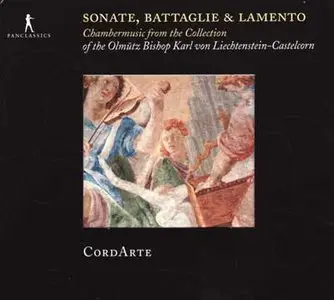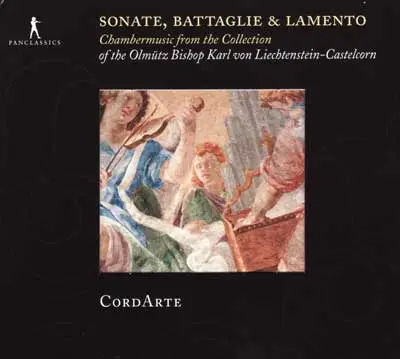Sonate, Battaglie & Lamento / CordArte Ens
Baroque | 2008 | 1 CD | 437 Mb | EAC/APE/CUE/LOG/SCANS
Baroque | 2008 | 1 CD | 437 Mb | EAC/APE/CUE/LOG/SCANS
Sonate, Battaglie & Lamento
Chambermusic from the Collection of the Olmütz Bishop Karl von Liechtenstein-Castelcorn
Johann Kaspar Kerll (1627-1693)
Canzona a 3, 2 Violini, Fagotto overo Viola da Gamba in G major
2 violins, bass viol and basso continuo (organ)
Alessandro de Poglietti (died 1683)
Sonata a 4 in G minor
violin, alto, bass viol, violone/harp and basso continuo (organ)
Alessandro de Poglietti
Sonata a 3 in C major
2 violins, violone and basso continuo (harp and harpsichord)
Alessandro de Poglietti
Sonata a 2 in D major
violin, bass viol and basso continuo (harpsichord)
Anonymus (17th century)
Aria Adagio in D major
bass viol and basso continuo (harp)
Philipp Jacob Rittler (about 1639-1690)
Sonata Violino, Violetta et Viola […] in G minor
violin, alto, bass viol and basso continuo (harp and organ)
Johann Fischer (1646-1716)
Balletto à 4: Sonatina - Allemanda - Menuet /Menuet 2 - Bourrée - Sarabande in C minor
violino piccolo discordato, violin, bass viol and basso continuo (violone, harp and harpsichord)
Antonio Bertali (1605-1669)
Sonata a 3 in D minor
2 violins, bass viol and basso continuo (violone and organ)
Alessandro de Poglietti
Sonata a 2, Sola Gamba et Violin in D minor
violin, bass viol and basso continuo (harp and organ)
Alessandro de Poglietti
Sonata à 4 in D major
2 violins, alto viol, violone and basso continuo (harp and harpsichord)
Johann Heinrich Schmelzer (1620/23-1680)
Sonata Lamentevole in B flat major
violin, alto, bass viol and basso continuo (violone and organ)
Anonymus/Johann Kaspar Kerll?
Sonata à 2 Violini in F major
2 violins, bass viol and basso continuo (harp and harpsichord)
Antonio Bertali (1605-1669)
Sonata à 2 [sic] in E minor
violin and basso continuo (bass viol and harpsichord)
Johann Kaspar Kerll (1627-1693)
Sonata à 3 in G minor
2 violins, bass viol and basso continuo (harp and organ)
Release notes
The members of the Ensemble CordArte function as treasure seekers on their new CD, bringing musical jewels of the 17th century from Kremsier to the ear in a highly engaged way. The sonatas, battaglias and the lamento all emanate from the 1400 works of the comprehensive collection of the bishop of Olmütz Karl von Liechtenstein Castelcorn.
The instrumental music of 17th Century Germany and German speaking countries survives largely in three collections of manuscripts. The first, integrated into the National Library of France, is the musical collection of Sebastian Brossard (1655-1730). While holding the position of Capellmeister at the cathedrals of Strassburg and Meuax, out of scholarly interest and a love of books he compiled a collection of 1000 items, in addition to his own 250 works. The second is to be found in the University library of Uppsala, Sweden, which has possessed since 1730 a collection named after Capellmeister Gustav Düben, consisting of 1500 vocal and around 200 instrumental works. Apart from rudimentary scattered collections in Kassel, and the unique Partiturbuch Ludwig from the year 1665 in Wolfenbüttel, it is the collection of the Olmütz Bishop Karl von Liechtenstein-Castelcorn which is of special value. Brought together between the years 1664 and 1695, it consists of over 1400 compositions, including 225 Sonatas and 236 ballets. It is of particular interest that a considerable number of works are dated and annotated with indications of performance practice, and are accompanied by correspondence between the Archbishop and various musical agents and composers, as well as a Consignatio Authorum Instrumentorum- an inventory of musical instruments, including who made them.
The diocese of Olmütz in the 17th Century encompassed the entire Moravian empire and was elemental in reconverting the rebellious populace to Catholicism. The summer residence of the Archbishop had been located in Kremsier since 1500. In 1643 it was destroyed by Swedish troops, and still lay in ruins when Karl von Liechtenstein took up office, succeeding two archdukes whose most notable feature was their frequent absence. Within a short time however, the city blossomed into a baroque jewel. The imperial architects Lucchese and Tencalla modernised the palace and constructed a gigantic garden around the city with a central dome and a 250 meter long colonnade. In any case, by 1673 Kremsier must have been sufficiently rebuilt that the bishop was able, in conjunction with the Cologne banker family Imstenrath, to close a deal involving the acquisition of 280 pictures from the collections of the English King Charles II (who was forced to auction them off), and the Earl of Arundel (UK). The collection included the picture The Flaying of Marsyas" by Titian, which is still on display in Kremsier.
As master of his court chapel, (a position which must also have been held between 1663 and 1670 by Heinrich Biber), the bishop appointed the trumpeter and Vienna-trained composer Pavel Vejvanovski (died 1693), whose Slavic ethnicity would presumably have helped in winning over the large part of the bishops subjects (Kremsier being situated in present day Czech Republic). No documents have yet come to light regarding the instrumentation and number of players in the chapel, however we are able to conclude, from the evidence in both compositions and musical instrument inventories, that it must have included 12 singers, six wind players, (who were primarily trumpeters, but well able to play other instruments on demand, including trombones, cornetts, oboes and recorders), as well as a substantial string orchestra. Why else should the bishop require 12 violins (four of these by the Austrian luthier Jacob Stainer), 11 violas (seven from Stainers workshop), and three violoncelli? If we interpret this evidence correctly, it seems that also in Kremsier, as in contemporary Rome and Paris, the orchestra was evolving into existence. The previous principle of one player per part was gradually giving way to the concept of multiple players to a part. In fact, one frequently finds the instruction radoppiate (doubled) in the Kremsier string parts.
If the sheer quantity of catalogued compositions suggests rather strongly that the Bishop could be characterised as a music lover, this is confirmed by the appearance in the inventories of special instruments: two piccolo violins, two violas damore and two violas da gamba, as well as pieces composed for them. This collection has survived more or less intact, having lost few works, making those losses which are known all the more bitter. Works such as Bibers Lyra Speculativa and Salve Regina, and Schmelzers Chaconne for violin solo without further accompaniment have unfortunately been lost. The chapel largely followed the musical fashions of Vienna, with a large and colourful repertoire of works, including such surviving gems as Schmelzers Cuckoo Sonata and Bibers famous Sonata representativa; numerous Battaglia; jocular Sonatas like the anonymous Sonata Jucunda and Bibers Pauren Pilgrimage; avant garde works such as Vejanovskys entrancing Harmonia Romana and Georg Muffats violin sonatas. In his letters to Schmelzer, the Bishop makes frequent mention of verstimbten Sachen- detuned things, which refers to works for Scordatura violin, where the strings are tuned differently to normal. All this was played alongside the contemporary French style, which, like the Menuet, was quite simply ignored in Vienna, due to the continuing Habsburg-Bourbon feud.
Todays understanding of repertoire from various 17th Century European chapels shows that composers did not expect their works to be performed multiple times at different courts, but instead allowed their sovereigns a certain degree of exclusivity. For this reason, concordances (multiple sources of the same work) are few, and when they do exist, are primarily those of exemplary compositional quality or, as the case with Schmelzers Kremsier ballets, have a particular political function rather than being purely artistic or asthetic.
Careful examination of instrumentation allows us to perceive the Olmütz Bishops taste for large heterogenous orchestration, with up to 20 obbligato parts. These pieces were not easily able to be performed in other places, due to the sheer size of the forces required. In large works in particular, he loved to use an entire squadron of violas, and in smaller chamber combinations, would prefer ensembles with three or four different sized string instruments.
The content of this repertoire allows on the one hand continual fostering of the marvels contained within, and on the other hand requires training and sharpening of the ear. Sometime we will be able to talk about Kremsier and its style between 1664 and 1685 not only ethereally but also in detailed objectivity. The recording here presented deserves attentive listening…
Reinhard Goebel (Translation: Nadia Johnson)
2008 PANCLASSICS PC10206
EAC/APE/CUE/LOG/SCANS
Rar store only, 437 Mb



